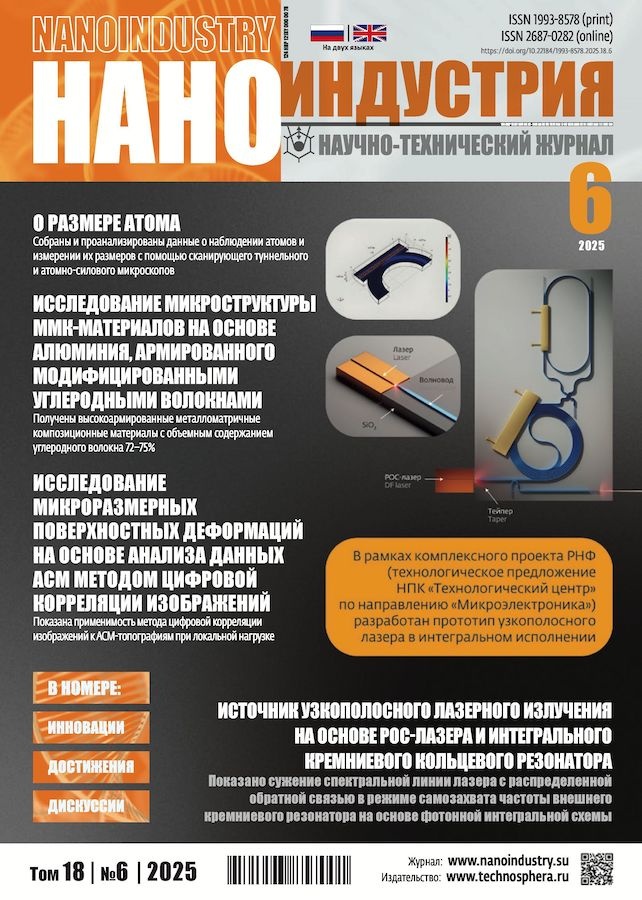Coronavirus morphology study using atomic force microscopy
- Authors: Akhmetova A.I.1,2, Kordyukova L.V.1, Yaminsky I.V.1,2
-
Affiliations:
- Lomonosov Moscow State University
- Advanced Technologies Center
- Issue: Vol 18, No 6 (2025)
- Pages: 336-344
- Section: Nanotechnologies
- URL: https://journals.eco-vector.com/1993-8578/article/view/692435
- DOI: https://doi.org/10.22184/1993-8578.2025.18.6.336.344
- ID: 692435
Cite item
Abstract
Atomic force microscopy allows high-resolution visualization of enveloped viruses, which include viruses of the Coronaviridae family, to study the nature of their adsorption on various surfaces, to measure the mechanical properties of viruses, to assess the effect of changes in the environment and temperature on morphology. Using force curves, it is possible to calculate the Young’s modulus of a viral particle, to assess the nature of the interaction between the envelope protein and the cellular receptor, and even to measure the strength of this interaction. All these capabilities not only allow us to characterize viruses, but also help prevent the spread of pathogens in the human population and choose the optimal treatment strategy.
Full Text
About the authors
A. I. Akhmetova
Lomonosov Moscow State University; Advanced Technologies Center
Email: yaminsky@nanoscopy.ru
ORCID iD: 0000-0002-5115-8030
Cand. of Sci. (Physics and Mathematics), Senior Researcher, Leading Specialist, Physical Department
Russian Federation, Moscow; MoscowL. V. Kordyukova
Lomonosov Moscow State University
Email: yaminsky@nanoscopy.ru
ORCID iD: 0000-0002-6089-1103
Doct. of Sci. (Biology), Leading Researcher, A.N. Belozersky Institute of Physico-Chemical Biology
Russian Federation, MoscowI. V. Yaminsky
Lomonosov Moscow State University; Advanced Technologies Center
Author for correspondence.
Email: yaminsky@nanoscopy.ru
ORCID iD: 0000-0001-8731-3947
Doct. of Sci. (Physics and Mathematics), Prof., Director General, Physical Department
Russian Federation, Moscow; MoscowReferences
- Kordyukova L.V., Shanko A.V. Covid-19: Myths and Reality. Biochemistry. 2021. Vol. 86. No. 7. PP. 964–984. https://doi.org/10.31857/S0320972521070022
- Akhmetova A.I., Yaminsky I.V. High resolution imaging of viruses: scanning probe microscopy and related techniques. Methods. 2022. Vol. 197. PP. 30–38. https://doi.org/10.1016/j.ymeth.2021.06.011
- Akhmetova A.I., Yaminsky I.V. FemtoScan Online software in virus research. NANOINDUSTRY. 2021. Vol. 14. No. 1(103). PP. 62–67. https://doi.org/10.22184/1993-8578.2021.14.1.62.67
- Kiss B., Kis Z., Pályi B., Kellermayer M.S.Z. Topography, spike dynamics, and nanomechanics of individual native SARS-CoV-2 virions. Nano Letters. 2021. Vol. 21. PP. 2675–2680. https://doi.org/10.1021/acs.nanolett.0c 04465
- Bagrov D.V., Glukhov G.S. et al. Structural characterization of β-propiolactone inactivated severe acute respiratory syndrome coronavirus 2 (sars-cov-2) particles. Microscopy Research and Technique. 2022. Vol. 85. No. 2. PP. 562–569. https://doi.org/10.1002/jemt.23931
- Cardoso-Lima R., Souza P.F.N. et al. SARS-CoV-2 Unrevealed: ultrastructural and nanomechanical analysis. Langmuir. 2021. Vol. 37(36). PP. 10762–10769. https://doi.org/10.1021/acs.langmuir.1c 01488
- Yao H., Song Y. et al. Molecular Architecture of the SARS-CoV-2 Virus. Cell. 2020. Vol. 183. PP. 730–738.e13. https://doi.org/10.1016/j.cell.2020.09.018
- Astuti I., Ysrafil Y. Severe Acute Respiratory Syndrome Coronavirus 2 (SARS-CoV-2): An overview of viral structure and host response. Diabetes Metab. Syndr. Clin. Res. Re. V. 2020. Vol. 14. PP. 407–412. https://doi.org/10.1016/j.dsx.2020.04.020
- Xue Y., Ma Y. et al. Identification and measurement of biomarkers at single microorganism level for in situ monitoring deep ultraviolet disinfection process. IEEE Trans NanoBioscience. 2024. Vol. 23(2). 242–251. https://doi.org/10.1109/TNB.2023.3312754
- Tomás A.L., Reichel A. et al. UV-C irradiation-based inactivation of SARS-CoV-2 in contaminated porous and non-porous surfaces. J Photochem Photobiol B: Biol. 2022. Vol. 234. P. 112531. https://doi.org/10.1016/j.jphotobiol.2022.112531
- Celik U., Celik K. et al. Interpretation of SARS-CoV-2 behaviour on different substrates and denaturation of virions using ethanol: an atomic force microscopy study. RSC Ad. V. 2020. Vol. 10. P. 44079 https://doi.org/10.1039/D0RA09083B
- Lyonnais S., Hénaut M., Neyret A. et al. Atomic force microscopy analysis of native infectious and inactivated SARS-CoV-2 virions. Sci Rep. 2021. Vol. 11. P. 11885. https://doi.org/10.1038/s41598-021-91371-4
- Kordyukova L.V., Moiseenko A.V., Trifonova T.S., Akhmetova A.I., Gracheva A.V., Korchevaya E.R., Yaminsky I.V., Fayzuloev E.B. Study of cold-adapted attenuated SARS-CoV-2 mutants by transmission, cryoelectron and atomic force microscopy. Bulletin of Moscow University. Series 16. Biology. 2025, Vol. 80. In press.
- Lim K., Nishide G. et al. Millisecond dynamic of SARS-CoV-2 spike and its interaction with ACE2 receptor and small extracellular vesicles. Journal of Extracellular Vesicles. 2021. Vol. 10(14). P. e12170. https://doi.org/10.1002/jev2.12170
- Yang J., Petitjean S.J.L. et al. Molecular interaction and inhibition of SARS-CoV-2 binding to the ACE2 receptor. Nat Commun. 2020. Vol. 11. P. 4541. https://doi.org/10.1038/s41467-020-18319-6
- Kukushkin V., Ambartsumyan O. et al. Lithographic sers aptasensor for ultrasensitive detection of sars-cov-2 in biological fluids. Nanomaterials. 2022. Vol. 12. No. 21. P. 3854. https://doi.org/10.3390/nano12213854
- Kurmangali A., Dukenbayev K., Kanayeva D. Sensitive detection of SARS-CoV-2 variants using an electrochemical impedance spectroscopy based aptasensor. Int J Mol Sci. 2022. Vol. 23(21). P. 13138. https://doi.org/10.3390/ijms232113138
Supplementary files









